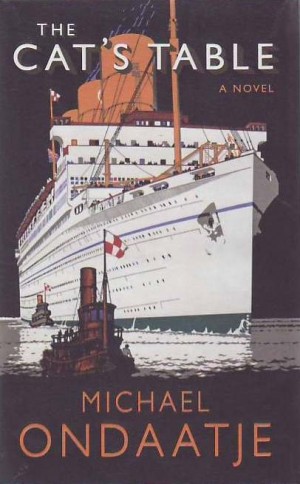In the early 1950’s, a young boy raised in Sri Lanka boards a massive ocean liner bound for London–a ‘castle that was to cross the sea.’ At mealtimes, Michael is placed at the dining table farthest from the captain’s, nicknamed ‘the Cat’s Table’ by the eccentric group of adults he dines with. Michael soon builds friendships on the Oronsay with two other young boys; weak, philosophical Ramadhin, and tough, betel-chewing Cassius. Although initially wary of each other, the boys soon band into a gang, roaming unsupervised around the liner, slipping in and out of strange and dangerous situations, ‘bursting all over the place like freed mercury.’ As the ship makes its way across the Indian Ocean, through the Suez Canal, and onwards towards Europe, the boys find themselves entangled in the eclectic lives of the grownups they observe from their vantage points of youthful invisibility.
Emily, Michael’s beautiful young cousin, dallies in secret with Sunil, a juggler and illusionist whose motives may or may not be honest. Mr. Daniels is transporting a vast and mysterious garden of exotic and poisonous plants in the hold. Max Mazappa, aka Sunny Meadows, is the jazz musician who attracts Miss Lasqueti but leaves the ship unexpectedly at Port Said. And at night, the boys spy on a shackled prisoner – his crime and fate a tragic puzzle that will haunt them forever. The narrative dips between the past and the present, weaving a vivid portrait of a half-way time between childhood and adulthood when Michael was ‘free of the realities of the earth.’
I don’t read literary fiction very often these days, but I’ve read Ondaatje before and usually enjoy his strong but lyrical prose and intricate structuring. I was not disappointed with The Cat’s Table. Ondaatje’s pacing is terrific; he spends just enough time on each scene to brilliantly weave together a vivid portrait of a time and a place, but does not linger on unnecessary descriptions or unimportant events. And as we follow the boys through their ship-bound escapades, seemingly unconnected incidents connect in a dizzying spiderweb, intricate and complex.
Presented as a memoir or autobiography, the narrative jumps back and forth between the past, the recent past, and the present, focusing not only on the the narrator’s experiences on the Oronsay but also his adult musings about the three weeks that irrevocably changed his life. Ondaatje balances the fantastical carelessness of childhood with an adult’s learned understanding of the world, contrasting dreamlike innocence with the oppression of realism. Much of Ondaatje’s writing treads the line of magical realism, offering up strange and wondrous events but allowing the reader to decide was is real and what exists only in childhood fancy.
There is a story, always ahead of you. Barely existing. Only gradually do you attach yourself to it and feed it. You discover the carapace that will contain and test your character. You will find in this way the path of your life.
This novel is beautiful, plain and simple. The intricate structure draws the reader in, teasing and hinting at tragedies and romances yet to come or long forgotten. The prose is sumptuous yet respectable, the descriptions clean and eloquent. The Cat’s Table is the story of one sea voyage many years ago, but it is also a deadly paean to lives twisted awry; to misplaced devotion; to the floating dream of childhood that eventually ends for us all.

0 Comments